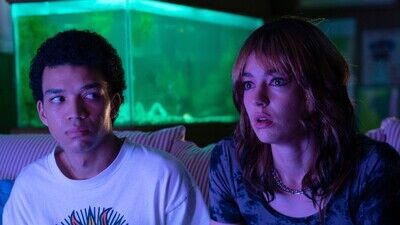Though Owen’s insecurities could be interpreted as being related to gender dysphoria, while watching “I Saw the TV Glow,” I also kept returning back to Jordan Peele’s “Us.” That film uses an earlier decade, the 1980s, and its reductive politics as a launching point to render the horrific economic legacy of Reagan’s America through the eyes of a Black nuclear family’s misplaced desire for upward mobility through crass consumerism. Television also plays a powerful role in that film: A commercial for “Hands Across America” inspires a young Addy to plan a revolt after her mind is awakened to the systemic inequality that comes from the many living a nightmare so a few might live a dream. Like Addy, the television unmoored Owen’s place in this picturesque town. He is enlivened by the lies of Clinton’s America, when forced homogenization—by way of bills like “Don’t Ask, Don’t Tell”—created the illusion of progressivism and diversity amid consumerist fantasies. It’s telling how not only is Owen one of the few Black faces we see in town, but he also immediately gravitates toward Maddy, a person whose identity and close relationship to television has also awakened them to the curated lies of suburban life. For Maddy, television, like Addy, becomes a roadmap for revolt. On the other hand, television as a medium—where Black subjectivity is shaken, reimagined, and then re-lived—frightens Owen enough to embrace the safe, stifling fantasy of blending in by leaving yourself undefined.
Far too often, when filmmakers graduate up the ledger, they become conservative, safe, and careerist; it feels like they’re making the current film solely with the mindset of remaining at the budgetary level they’ve just attained. With “I Saw the TV Glow,” the director’s glossy follow-up to their resourcefully executed “We’re All Going to the World’s Fair,” Schoenbrun films like a director who doesn’t want to live in regret of the shot they didn’t get, the risk not taken, the leap that never left the ground. The earworm original soundtrack, exciting practical effects, intoxicating photography, and risky editing—blending together conscious and imagined worlds—are the big, adventurous swings of an undaunted filmmaker.
That creative courage translates to the film’s arresting performances. Lundy-Paine is unwavering, playing Maddy as the kind of person whose direct exterior belies the pain seen in their closed in-frame and averted gaze. As Owen, Smith, at first, mirrors Lundy-Paine’s posture. But before long, following their characters’ emotional journeys, their shared physicality diverges: Lundy-Paine strikes a broad, self-assured pose, while Smith shrinks his chest to the point of being nearly caved in. Smith is especially incredible, transforming organically without ever feeling gimmicky. His body is thoughtfully unassured; his voice eventually rattles like a man who died long ago; his eyes become vacant orbs where defeat has found a cozy home. His late, climatically cathartic scream, which gives way to a blissful smile, reverberates with the same intensity of Schoenbrun‘s “I Saw the TV Glow”—looping like a rerun that always feels fresh and new, no matter how many times you’ve seen it before.

